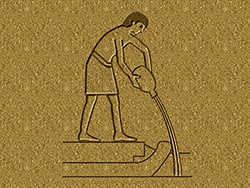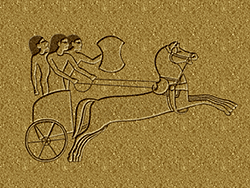History of Grease
Early History of Lubricant

According to the historical accounts, it is said that as early as 2400 B.C. grease-like substance, oil and water were used as lubricant to reduce friction.
In a painted wall relief of an Egyptian Pharaoh's tomb dated to around 2400 B.C., a worker is seen pouring lubricant (in this case, water) for moving statues.
Early History of Grease

Chariots from another Egyptian Pharaoh's tomb dated to around 1400 B.C. are found with what seems an early form of grease derived from animal fat on the axle.
While there are evidences showing the use of natural asphalt, most of the lubricating oil used in these times was based on animal or vegetable fat. It was only in modern times when grease formulated with petroleum lubricating oil came into use.
History of Grease (Based on thickener technology)
| around 1400 B.C. | Hittite chariots during the Pharaonic period were lubricated on the axle with a mixture of animal fat and limestone. |
|---|---|
| 1845 | Calcium grease using mineral oil, animal fat and limestone was invented in the U.S |
| 1853 | Sodium grease using beef tallow and sodium was invented in UK. |
| 1912 | Grease (calcium-based) production started in Japan. |
| 1938 | Lithium grease was invented and rapidly came into wide use as multi-purpose grease. |
| 1947 | Kyodo Yushi started grease production. |
| 1952 | The world's first urea grease was invented in the U.S. |
| 1954 | Aluminum complex grease was invented for high-temperature application. |
| 1972 | Kyodo Yushi started production of urea grease. |